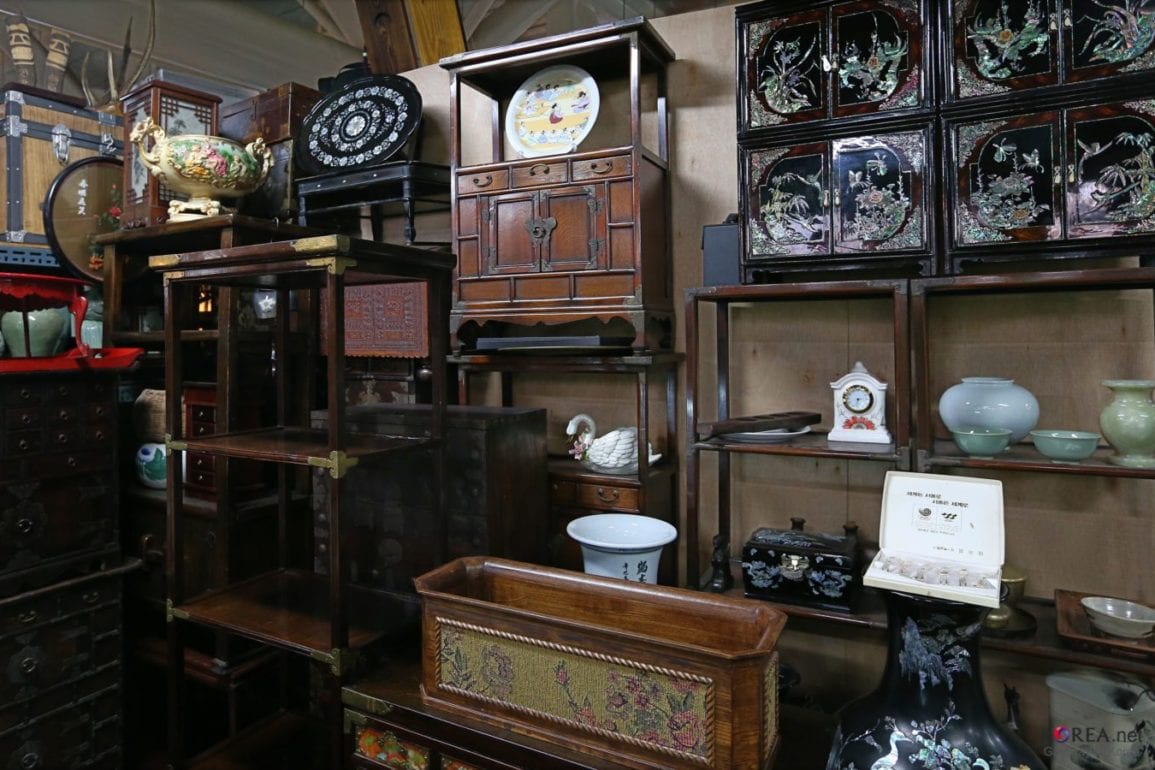Antique hunters can arm themselves with these useful tips before setting out in search of that perfect piece to add to their collection.
Western eyes twinkle with delight at the beautiful Asian-inspired furniture they see in the windows of local shops. The distressed finishes, hand-painted scenes and beautiful wood-carving details beckon you into the store.
Shoppers are hit with words and phrases like Xing Dynasty, Mongolia, and It’s an antique, and before you know it you’re asking them if they take credit cards and adding that, oh, by the way, you’ll take the life-sized clay warrior, too. What does all this furniture jargon mean, anyway?
When Foreigners Go Antique Shopping
Furniture shopping for expats all over the world can be somewhat of a daunting task, and the same can be said in Korea. The time spent exploring and finding just the right piece alone can be overwhelming, but you also have the challenge of a language barrier.
Understanding the local culture and customs can ease your shopping experience here in Seoul. There are no laws in Korea defining what is or isn’t an antique. With fewer and fewer original pieces left in Korea and the stiff competition, it is important that a relationship of trust be established between the buyer and the dealer. Most dealers will do their best to source a particular piece for a customer.
Typically an antique in Korea is any furniture that is more than seventy to eighty years old.
A reproduction is a piece of furniture that is made using new wood, but aged and distressed to look like an antique. Buyers must be careful when buying reproduction pieces especially here in Seoul with the harsh, dry winters. The first signs of cracking will send you running to the store to purchase humidifiers. On the contrary, the worn, weathered wood of authentic antiques will ride out the dry and humid seasons of Seoul beautifully. It’s a trade-off, and the prices of both types of furniture reflect that.
Common Traits of Korean Furniture
There are distinct characteristics of Korean furniture that differentiate it from other Asian style pieces. Korean carpenters historically focused on the beauty of the wood grain, versus a lacquered or painted finish. A beautiful sheen was achieved through a process of applying different seed oils and polishing the surface to accentuate the grain of the wood.
Similar to the Chinese craftsmen, Korean carpenters prided themselves on the use of durable joinery, such as the mortise and tenon joint. Unique to Korean antiques is the use of bamboo nails to reinforce joints a missing component in many reproduction pieces.
Furniture adornments and motifs found on Korean furniture are often symbolic. Cranes symbolize longevity and are a very popular decoration on furniture and ceramics in Korea. Other common symbols of longevity include the cypress, pine tree, deer, plum, and chrysanthemum.
Fish stand for wealth, while clouds represent good fortune and happiness. The butterfly is the emblem of joy and affection between a husband and wife; therefore, it is a common symbol found on women’s furniture items such as small chests and wardrobes.
Typically Korean furniture is smaller than furniture of other Asian countries. Land is at a premium in Korea, and the furniture reflects that. Smaller homes equal smaller furniture. Unlike the large chests and wardrobes you find in China and Indonesia, Korean furniture stores are full of charming little medicine chests, and trunks in beautiful dark wood finishes and lots of brass hardware. These mix wonderfully with both Western furniture styles and painted pieces from other Asian countries.
Shopping Locations for the Furniture Sleuth
Incorporating one or more Asian-style pieces into what you already own can enhance the ambiance of your interior living space and provide years of memories about your time living in Asia. Shopping for Asian furniture should feel like a treat instead of a task. Finding furniture stores that have a friendly staff and English-speaking owners is key to an enjoyable furniture-shopping experience. Read on to find my favorite English-speaking vendors.
Dae Boo Antiques
Owner Jin Kang has a treasure trove of antique and reproduction furniture and accessories from all parts of Asia and Indonesia and a large friendly dog to greet you at the front door. Many unique and hard to find items can be found here.
Where: 737-23 Hannam-Dong, Yongsan-gu
Hours: Open 10 am – 6:30 pm
Phone: 02-797-6787
Kojeon Antique
This store is more like a large warehouse that holds antique and reproduction Korean, Chinese and Tibetan-style furniture and accessories. Many large and hand-painted pieces can be found here. Be prepared for a day trip as this warehouse is about 1.5 hours outside of Seoul. Owner Agnes Lee makes you a delicious authentic Korean lunch when you arrive and offers free furniture delivery to Seoul. Shuttle service is available for larger groups.
Where: 361 Hwasan-ri, Idong-Myeon, Cheoin-gu, Yongin-si, Gyeonggi-do.
Hours: Open every day, but best to make an appointment.
Phone: 031-335-8851
Koreana Antique and Folk Craft
Two floors chock-full of Korean, Chinese and Tibetan style furniture. Owner Symon Jeonn is particularly knowledgeable about authentic Korean style furniture and has a welcoming smile for all visitors to his store.
Where: 736-8, Hannam-Dong (Itaewon Street), Seoul
Hours: Open 9 am – 7 pm (closed Tuesdays)
Phone: 02-790-6641
Oriental Mood
Owner Mi Sung has a delightful store filled with beautiful accessories, furniture and gifts from all parts of Asia. She also offers high-quality custom soft goods (such as bedding, pillows, and draperies) and 5-star customer service.
Where: 2nd Floor Vision Tower, 96-5, Banpo 4 Dong, Seocho-gu, Seoul
Hours: Open 10:30 am – 9 pm
Phone: 02-536-5280




